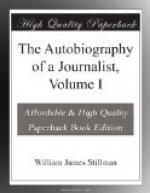The three years of my college course had left me little room or leisure for such studies, and at the end of them I realized that so far as the object I had set before me was concerned, I had wasted the years and blunted the edge of my enthusiasms. In preparation for the career which I proposed to myself I had, however, been in correspondence with Thomas Cole, then the leading painter of landscape in America, and an artist to this day unrivaled in certain poetic and imaginative gifts by any American painter. He was a curious result of the influence of the old masters on a strongly individual English mind, inclined to nature worship, born in England in the epoch of the poetic English school to which Girtin, Turner, and their colleagues belonged, and migrating to America in boyhood, early enough to become impressed by the influence of primitive nature as a subject of art. Self-taught in technique and isolated in his development, he became inevitably devoted to the element of subject rather than to technical attainment, and in the purely literary quality of art he has perhaps been surpassed by no landscape painter of any time. His indifference to technical qualities has left him in neglect at present, but in the influence he had on American art, and for his part in the history of it, he remains an important individuality now much underrated. It was settled that I should become his pupil in the winter following my graduation, but a few months before that he died.
At that moment there was not in the United States a single school of art, and except Cole, who had one or two pupils when he died, there was no competent landscape painter who accepted pupils, nor perhaps one who was capable of teaching. Drawing masters there were here and there, mostly in the conventional style adapted to the seminaries for young ladies. Inman, the leading portrait painter of the day, had taken pupils, but his powers did not extend to the treatment of landscape, and my sympathies did not go beyond it. I applied to A.B. Durand, then the president of our Academy, the only rival of Cole, though in a purely naturalistic vein, and a painter of real power in a manner quite his own, which borrowed, however, more from the Dutch than from the Italian feeling, to which Cole inclined. Durand was originally an engraver of the first order, and afterwards a portrait painter, but his careful painting from nature and a sunny serenity in his rendering of her marked him, even in the absence of imaginative feeling, as a specialist in landscape, to which he later gave himself entirely. His was a serene and beautiful nature, perfectly reflected in his art, and he first showed American artists what could be done by faithful and unaffected direct study of nature in large studies carefully finished on the spot, though never carried to the elaboration of later and younger painters. But he was so restrained by an excess of humility as to his own work, and so justly diffident of his knowledge of technique, that he could not bring himself to accept a pupil, and I finally applied to F.E. Church, a young painter, pupil of Cole, and for many years after the leading landscape painter of the country. He was then in his first success, and I was his first pupil.




